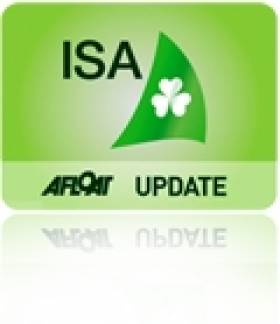Displaying items by tag: Irish Sailing Association
#SailorOfTheYear – Liam Shanahan has been named Afloat.ie Irish Sailor of the Year for 2015.
The Irish Sea yachtsman and June's Sailor of the Month was presented his award by Sport Ireland chief executive John Treacy at the Irish Sailing Awards gala in Dublin's Royal College of Surgeons this afternoon (Thursday 4 February).
Liam Shanahan wins overall 2015 Sailor of the Year https://t.co/MDaTjreQZG pic.twitter.com/Mnz6aEy9qK
— Irish Times Sport (@IrishTimesSport) February 5, 2016
Shanahan was recognised for his comprehensive victory in the 280-mile Dun Laoghaire to Dingle Race at the helm of Ruth, his family's J/109, marking the highlight of a busy June in Irish sailing.
Not one to rest on his laurels, Shanahan – and his dependable crew, especially so since they're family – would go on to retain the James Eadie Trophy in the ISORA Offshore Championship, fending off the strong challenge of Andrew Hall's J/125 Jackknife and Peter Dunlop and Vicky Cox's J/109 Mojito in the season's final race from Pwllheli to Dun Laoghaire in September.
And what's more, Shanahan was the clear choice of both the judging panel and Afloat.ie readers alike from the field of 17 individual and joint nominees, garnering 1,359 votes out of nearly 6,500 cast.
In accepting his prize, Shanahan said it was "an award for Corinthian and family sailing", which he regards as the heart and future of the Irish sailing scene.
Hosted by entrepreneur Bobby Kerr along with Afloat.ie's WM Nixon and Irish Sailing Association (ISA) president David Lovegrove, the Irish Sailing Awards also recognised the ISA Youth Sailor of the Year and Training Centre of the Year, as well as the Mitsubishi Motors Club of the Year.
Guests at the event included members of the ISA's Olympic and youth sailing squads, national senior and youth champions, class captains and club commodores, and a number of past Sailor of the Year awardees, such as 2012's winner George Kenefick.
2015 Afloat Irish Sailor of the Year winner Liam Shanahan at the Irish Sailing Awards today: Dublin @AfloatMagazine pic.twitter.com/sExNo1b4uy
— Irish Sailing (@Irish_Sailing) February 4, 2016
Celebrating 20 Years of Ireland's Premier Sailing Award Today
This afternoon marks two decades since Afloat Magazine inaugurated the Sailor of the Month awards, with their peak achievement of the Sailor of the Year accolade – the latest of which will be presented at the Irish Sailing Association (ISA) Awards Ceremony in Dublin's Royal College of Surgeons at 2pm.
Created in 1996 – with the first prize going to dinghy sailor Mark Lyttle, a race winner at the 1996 Atlanta Olympics – the Sailor of the Year award represents all that is praiseworthy, innovative and groundbreaking in the Irish sailing scene.
The national award is especially designed to salute the achievements of Ireland's sailing elite, whether amateur or professional. After two decades, the awards has developed into a premier awards ceremony for water sports.
In the last 20 years the scheme has honoured over 320 sports sailors of every kind, of many ages, and from all parts of Ireland – occasionally adding special monthly awards for cruising, or international achievement, to name a few.
In 2016, as in previous years, the overall national award will be presented to one of the monthly winners from 2015 who, in the judges' opinion, achieved the most notable results in – or made the most significant contribution to – Irish sailing during the year.
And while the judges retain their right to make the ultimate decision, once again the boating public and maritime community can have their say to help guide the panel in making their choice for who should be crowned Ireland's Sailor of the Year for 2015 via an online poll that closed on Monday 1 February.
The Irish Sailing Association hosted ceremony starts at 1pm and also includes awards for: club, youth sailor and sailing school of the year.
The Sailor of the Year nominees:
January - Conor Clarke
Conor Clarke made a dream debut at the Key West Regatta with his Melges 24 Embarr, employing some dab Olympic-calibre hands – including Maurice 'Prof' O'Donnell – to claim overall victory with a race in hand.
February - Neil Hegarty
Cork's Neil Hegarty was awarded the Irish Cruising Club’s historic Faulkner Cup for his epic transatlantic cruise from Portugal to the Caribbean and the Eastern US – one he meticulously logged along the way.
March - Fionn Lyden
Fionn Lyden played a stellar role in bringing University College Cork’s First Team to overall victory in the Intervarsity Team Nationals at Schull – and was recognised as First Year Sailor of the Year for his efforts.
April - Anthony O'Leary
Our Sailor of the Year for 2014, Anthony O’Leary book-ended April with a runaway overall victory in the RORC Easter Challenge in the Solent and a convincing win in the Brooks Macdonald Warsash Spring Championship.
May - Rob McConnell
One of Waterford Harbour's most popular and enthusiastic skippers, Rob McConnell emerged as overall winner of the Silvers Scottish Series – setting some unfinished business after his second-place finish in 2014.
May (International) - Sidney Gavignet
It was forth time a charm for Sidney Gavignet when he helmed the Musandam-Oman MOD 70 trimaran like a rocked around Ireland to smash Steve Fossett's 1993 record by almost four hours.
June - Liam Shanahan
The comprehensive overall victory in the 280-mile Dun Laoghaire to Dingle Race by Liam Shanahan in his family’s J/109 Ruth was the highlight of a busy June in Irish sailing.
June International - Justin Slattery
In the Volvo Ocean Race, experience and exceptional sailing talent is at a premium – and Ireland’s Justin Slattery, a key crew member on the race winning Abu Dhabi boat, has both in abundance.
July Racing - George Sisk
'Gallant old codgers' they may be, but George Sisk and crew on WOW, his Farr 42, can still cut the mustard, as shown by their winning three demanding offshore races at the Volvo Dun Laoghaire Regatta to claim the Top Boat title.
July Cruising - Nathaniel & Fergus Ogden
Adverse conditions weren't enough to prevent the Ogden brothers competing their exceptional eight-week circumnavigation of Ireland in their 18ft Drascombe Lugger, Lughnasa, to raise funds for the RNLI.
August Offshore - Ronan O'Siochru
Not only skippering Desert Star to the Roger Justice Trophy in the Rolex Fastnet Race, but also finishing as the second best Irish boat in the whole fleet, Ronan O Siochru of the Irish Offshore Sailing school made dreams come true in August.
August Inshore - Shane McCarthy & Andy Thompson
Shane McCarthy and Andy Thompson flew the flag for both the GP14 dinghy in Ireland and their home club of Greystones SC at the British Nationals, following a skill-sharpening Irish season with a big title win before the final race.
August International - Dave Cullen
Howth's Dave Cullen did Irish sailing proud when he took his Checkmate XV to the Half Ton Classics Cup in Nieuwpoort, Belgium last August, winning both the admiration of his international peers – and the championship with a race to spare.
September - David Gorman & Chris Doorly
Dave Gorman and Chris Doorly's sporting performance in the Mitsubishi Motors Flying Fifteen Nationals – after taking the title in the penultimate race – was all it took to garner them September's award.
October - Dermot & Paddy Cronin
Sailing their keenly campaigned First 40.7 Encore, Malahide father-and-son crew Dermot and Paddy Cronin celebrated a clearcut win by almost two hours in the IRC Double-Handed Division of the Rolex Middle Sea Race.
November - Tim Goodbody
Tim Goodbody's enormous contributions to Irish and international sailing span many decades as an active participant (particularly as of late in the Sigma 33), race organiser and administrator of leading sailing bodies.
December - John Twomey
Sonar sailor – and former Kindle Yacht Club commodore – John Twomey qualified for an incredible 11th Paralympic Games after his and his crew's extraordinary performance at the Melbourne trials in December.
Read each sailor of the month's full citation here and WM Nixon's Who will win sailor of the year 2015 blog here
Ireland’s Boats & People – How Do We Get Them Together?
The recently-published ISA Survey of Club Racing commissioned and supervised by Board Member Jack Roy has started the process of putting together a realistic picture of how we sail and go afloat for recreation, and it was analysed on publication here in Afloat.ie.
It’s logical to have made the beginning with club racing, as racing provides its own narrative and a straightforward set of entry numbers and results. But it will become more complex as the national authority tries to provide realistic figures for day sailing’s less competitive aspects. And of course, once we enter the world of cruising as defined by sailing and boating projects which include passage making, both coastal and offshore, together with overnight on-board stops, then it can become much more difficult to get meaningful data.
Yet with the ISA’s Cruising Conference for February 20th already booked out within a few days of being announced on Afloat.ie, clearly that is an area in search of services and support, a section of sailing which is difficult to quantify yet obviously of strong interest to a significant number of boat enthusiasts. W M Nixon takes a look at how the complexity of our sport’s many specialities makes it difficult to provide a clearcut picture for possible recruits to sailing.
Where would we be without the International Optimist Dinghy? The little solo-sailing boxes and their attendant support teams of mum and dad and the dog and the old 4X4 or station wagon or people carrier or whatever may seem to take up an awful lot of space and time, and all just so that one little person can go sailing.
But at least that one little person does go sailing. The ISA figures are brutally straightforward. In terms of genuine turnouts afloat at clubs throughout Ireland, in boat numbers the active Optimists are exceeded only by the Lasers, and this is arguably because Lasers aren’t age-limited, whereas the Optimists most definitely are.

Optimist airborne. This is Ireland's second most popular class
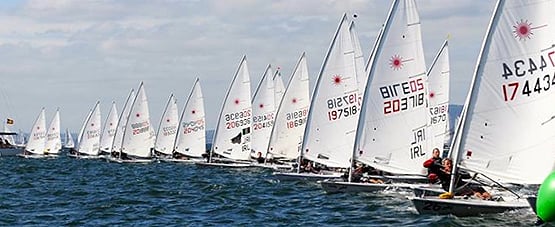
Ireland’s most popular dinghy class, the Laser is seen here at the Zhik Irish Nationals at Ballyholme
So we give a qualified cheer for the success of these two little boats. But it’s qualified because they’re single-handers which fail to provide any crew-relating sailing skills. Leading sailing figures as diverse as Des McWilliam of Crosshaven and Norman Lee of Greystones have been eloquent in promoting the notion that we should be doing more – much more – to encourage two-handed boats, and if we can persuade people into three-handed boats, well, so much the better.
Certainly that’s one of the reasons why our header photo says so much. A lone sailor in an Optimist or Laser promotes too much of a solitary, even an isolated image. And a two-handed boat like the GP 14, whose strong fleet figures in the ISA survey show the class’s vigour, is arguably just an act for a dynamic duo – it’s Strictly Come Dancing goes sailing…..
But getting three together to race a characterful boat like the National 18 with style – now that’s something special, that really is a superb combination of people skills interacting with sailing talent. And it’s a joy to behold. Yet anyone can see that for a complete beginner to sailing, this extraordinary silhouette of Tommy Dwyer’s National 18 against the November sky above the Hill of Howth will have an otherworldly air about it – “That’s not for me” is as likely a response as “Let’s have a go at that”.
Even those of us who have been in sailing for longer than we care to remember find the image decidedly thought-provoking, for we have some idea of what has been involved in creating the circumstances for this seemingly effortless balancing act, this lighter-than-air effect in the unlikely setting of a November afternoon.
Over the past year or so we have been recounting in Afloat,ie how the Cork Harbour National 18 Class, with very tangible backing from the Royal Cork Yacht Club, have been in the forefront of the development of the new ground-breaking Phil Morrison take on the long-established National 18, which is a developmental class which from time to time takes a leap in hull design, and moves forward in order to keep the spirit alive.
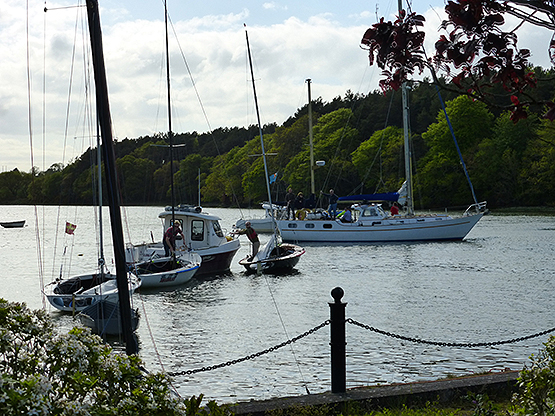
The National 18s are part of the fabric of Cork Harbour sailing. Before the new Morrison boats arrived in July, the old fleet were seen here in May 2015 after their annual race to Ballinacurra in northeast Cork Harbour in company with the Dwyer brothers’ cruising ketch. Photo: W M Nixon
Acceptance of this is something which seems to be bred into Cork’s National 18 enthusiasts, many of whom have the advantage of being firmly of the opinion that a proper dinghy needs three people to sail it. But the social matrix which has built up around Cork Harbour over many decades with this concept at its heart is not something which will necessarily travel easily to other areas, and although the six boats of the National 18 flotilla which visited Howth for the Open Day got a great reception and gave many people from other classes a marvellous time afloat, it’s probable that the very different mood around sailing in Dublin means that something so technically and socially challenging as a three man dinghy is a step too far.
Sailing in the greater Dublin area seems to exist within a framework of independent balloons. While there are those who will happily move from one boat type to another and cheerfully spread their talents and enjoyment about, by contrast there’s the Dublin Bay Sailing Club Thursday Evening Phenomenon.
Thursday is when the DBSC cruiser classes go out to race. And there’s an entire cohort of people, mostly folk who work in offices in the city, who on a Thursday evening go straight to Dun Laoghaire, get aboard a pontoon-based cruiser owned by someone else, go out and race in some very specific crewing job, then come back in and have supper in club or pub with their shipmates, and then that’s it until next Thursday. Just one evening each summer mid-week is their entire sailing programme. Weekends are for something else. And as for the hassle and mixed joys of boat ownership and maintenance, that’s not their department at all.
It’s a very metropolitan, very citified yet specialized way of doing things, and Dublin is one of the very few cities whose location facilitates it. It will be fascinating to measure it, for Dublin’s way of sailing is steeped in history and tradition. But for now it’s refreshing to look at a place which has had a sailing tradition in times past, but somehow lost it, yet it’s coming back again, and one of the good news stories towards the end of 2015 is that the new Youghal Sailing Club has been accepted into the ISA fold.
Youghal at present is a difficult place for sailing, as the tidal power of the mighty Munster Blackwater sweeps straight through the estuary and along the old town’s waterfront, and the creation of any meaningful modern facilities will have the immediate difficulty of silting by incredibly adhesive black mud.

With the sun out, and the tide in, Youghal looks to be an ideal location for the easy installation of a marina….....Photo: W M Nixon
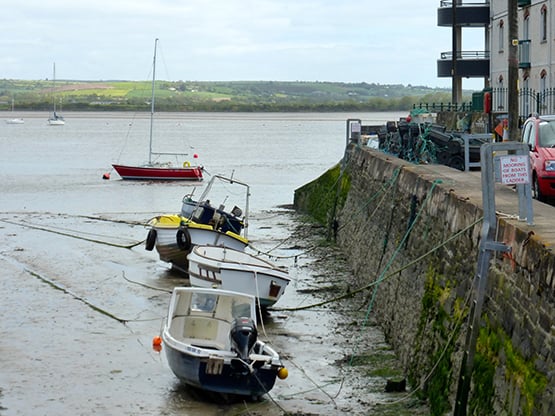
….but with the sun in and the tide out, the mud problem is revealed. Photo: W M Nixon
Thus, as dedicated Afloat.ie readers will have recently observed, no sooner had one group announced that a marina in Youghal was on the way than another longer-established group quietly suppressed the story, as they’re well aware of the engineering and dredging difficulties involved, and premature announcements will only slow any project in the long run.
In the fullness of time, a marina at Youghal will be a godsend for any cruiser plugging along the south coast. It’s not always the easiest coast in the world to make a passage along, sometimes it can seem an awfully long way to Cork from Dunmore East or Kilmore Quay even if you do make stopovers at Dungarvan or Helvick, and there are times when the hardiest seafarer is glad enough to get his boat secured to a good big pontoon.
But that’s for the future. Meantime, the locally-based keelboats are using either the restless anchorage off the town, or the more serene pool across the estuary at Ferry Point on the east shore, while the new club’s flotilla of GP 14s are stored in spare warehouse space during non-sailing time, and when they do go sailing it turns out their clubhouse is a moveable feast - it’s a caravan which can be towed to a choice of sailing locations.
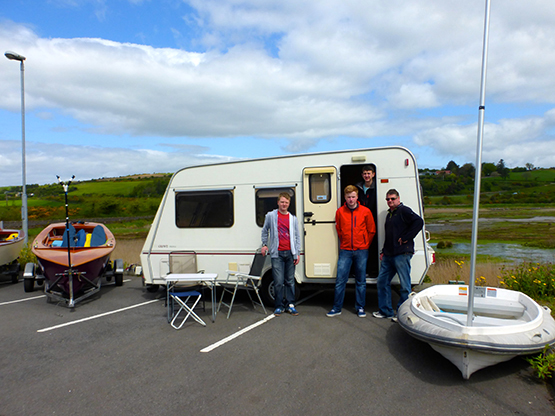
A moveable feast. Members of the newly-affiliated Youghal Sailing Club with their caravan HQ, Adrian Lee in doorway. Photo: W M Nixon
On the national stage, it is young Youghal GP 14 sailor Adrian Lee who has been among those flying the club’s flag, and there’s hope in the air. When we were there in May on a fine day that promised a summer which never arrived, we couldn’t help but think that when they do get their facilities and maybe even a clubhouse, they’ll look back to the days of the caravan and ad hoc racing arrangements with sweet nostalgia. For sometimes, it’s much better to be travelling than it is to arrive.
But for the rest of us, the message from Youghal is simple. The sea is for sailing. Use it or lose it. By all means get proper people surveys done which indicate the way numbers are shaping up and things are going. But really, if you want to persuade people to go sailing, the best way is by example, getting afloat as much as possible yourself. And maybe then you’ll find the time to welcome aboard newcomers too.

Reviving Youghal sailing – on race days, the club’s caravan is simply towed down to the pier and the races are started from there. Photo: W M Nixon
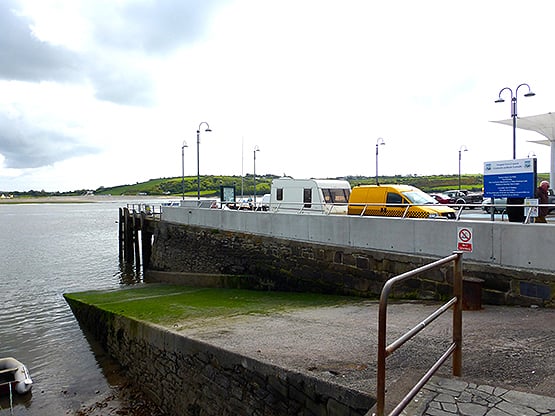
Youghal’s massive public slip provides launching for the YSC sailing dinghies, but during 2015 the boats had to be stored at the other end of town when not in use. Photo: W M Nixon
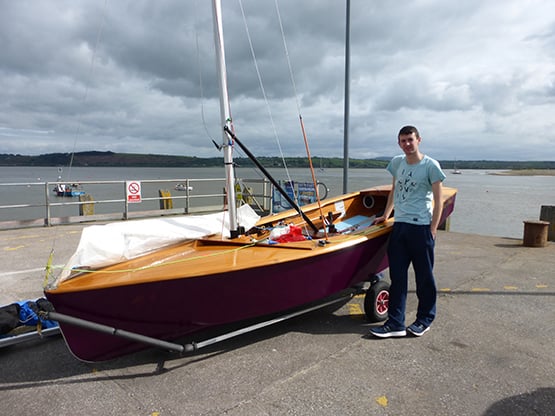
The pace-setter. Adrian Lee of Youghal SC with his Duffin-built GP14. Photo: W M Nixon
Click to download: ISA Survey of Club Racing
Keelboat racing accounts for about two thirds of active racing sailors, a thriving junior single-hander dinghy ‘pathway’ scene is the envy of all other fleets and it makes up 31% of all dinghy sailors (51% of dinghies), according to a new Irish Sailing Association (ISA) club racing survey published recently. A pdf of the full report is downloadable below.
The first snapshot of Irish club racing reveals little new of the 'segmented' national racing fleet, but provides a welcome and robust basis for the ISA, clubs, classes and sailors alike, on which to build and evolve.
According to the report, there is a total of just under 7,000 sailors actively racing in Ireland. Junior single-handers get four times the coaching of everyone else. Senior dinghy sailing is almost non existent in the major sailing centres. One fifth of clubs have no club racing and 25% have no interest in hosting visiting events. These are just some of the conclusions of a report where, the ISA say, the detail of input from some of the clubs was 'varied'.
As sailing clubs and classes found out in 2013, the ISA, charged with developing the sport, had little idea about what type of boats clubs had or what sort of activities they got up to. Fast forward three years and this situation has changed with the publication of this worthwhile fact finding exercise revealing what is really going on.
Part of the reason behind the survey was to deal with ongoing concern that nominated dinghy classes form an elitist High Performance (HP) pathway that 'exclude' strong sailors in other fleets.
The survey, commissioned by International Race Officer Jack Roy, an ISA Director, was sent out in March 2015 with data to be based on the 2014 season. The survey was emailed to the Commodores and Sailing Secretaries of the 57 affiliated clubs that have sailing activity. A total of 52 responses were received, a response rate of over 90%.
Recently appointed ISA director Sarah Byrne, an RS sailor, says the report gives a picture of the 'segmented' Irish fleet and the current overall situation is 'unfortunate' and 'does not serve competition well, without the critical mass to sustain so many classes on active circuits'.
The report is far from perfect but as a first cut at what boats are actually sailed in Ireland and where and roughly how many people are actively sailing it represents an important piece of work. There are acknowledged gaps in the information such as:
a. Northern Ireland – this information was pursued through the RYANI albeit in October/November, but has not been received to date. The ISA say they will pursue a more complete picture of all-Ireland sailing in the future.
b. Non-affiliated Clubs and independent groups of sailors are also excluded (eg GP14s in Youghal)
c. Those that do not participate in club racing but just event.
The survey reveals some other interesting facts too, such as how many clubs don't have racing at all and those clubs not interested in organising events.
The report is therefore a valuable and deserving of wide distribution and plenty of discussion.
The survey shows that 20% of clubs have no club racing and 25% no interest in hosting visitors. Deciding on how to deal with this scenario is the next step, should they be left to their own devices or does the ISA need to visit them and explain how club racing and event running pulls clubs together and keeps people involved and showcases them to possible new members and is important for their continued viability?
Also among the findings it is reported that in the major sailing centres approximately 60% of juniors are trained in single handers and 60% of senior dinghy sailors are single handers.
There is localised depth and strength of some one-design classes where there is a strong social scene and good class association (eg 1720, Waterwags and Shannon OD).
Single–hander v Double–hander
Senior dinghy sailing is almost non–existent in the major centres but relatively good outside of them. In the main sailing centres, keelboat racing prevails. Where the ISA is strongest and 'Development Squads' exist, single handers predominate and club racing flounders, in other areas the scene does exist.
Greystones dinghy sailor, Norman Lee, a long time advocate of the need to reformat current ISA thinking, has read the report and points to a need to change the training emphasis from juniors in single handers to double handers. Lee suggests where possible using double–handers also used by seniors to aid integration and transition.
Appendix 4 in the report is drawn from the classes forum of 14/11/15 and it notes the 'upside down' nature of training and coaching for sailing in Ireland; the junior pathway being heavily weighted towards single–handed sailing where very little or no club racing is done in single handers. Club racing virtually all done in double or multi handers.
Lee estimates this 4:1 coaching ratio is backwards and needs to be reversed more in favour of double handed sailors. 'If the sport is serious about bringing on the sort of sailors we need in club racing this needs to be predominantly done in multi handed dinghies and keelboats'.
'This seems blindingly obvious to me and I feel it needs to be brought to the attention of everyone interested in growing club participation' he says.
The data also illustrates that participation rates are higher where there is a one design or club pathway policy.
Sarah Byrne of the ISA says: The single-hander youth training bias and the ‘elitist’ high performance pathway, against a background of ‘adult’ double-hander preference, are held up by some as agents of death for sailing. However there is nothing extraordinary in the attrition rate from sailing when compared to other sports, whether in Ireland or abroad. We certainly punch way above our weight in terms of international performance and it is clear Annalise Murphy has been an inspiration to our junior females and no doubt, despite a very small active Irish class, recent 420 Youth Worlds success, HYC Doug and Colin too, have and will continue to, enthuse their peer group in turn.
Molly Coddled Youths?
But getting youths to transition from 'molly-coddled' junior and youth classes (coaches, rib support, ISA squads, foreign racing/coaching trips) to the independent world of racing a GP14, Fireball, RS 200 or whatever, is perhaps like asking Johnny Sexton to politely give it all up and turn out for his local Rugby Club on a Saturday afternoon, where the only perk would be the slice of orange at half time!
If we are all to 'sail double handers and have fun'. What more can be done to achieve this? Where's the incentive?
Byrne says 'the exceptional aspect of sailing in that you can remain at the top of your game well into and beyond middle age and often compete in multi-generational fleets. What’s not to love?'
But, how realistic is a €400 a year coaching grant for a senior class to do anything (roughly €20 euro a boat at a 20–boat coaching weekend)?
Combined events?
In the report, combining events to get numbers up to a viable level also comes in for mention but the perceived wisdom of combining fleets for events – a nostalgic throwback to IYA Dinghy week perhaps – plus clubs whingeing about low profits from events, depresses turnouts in total over a season because it takes the pressure off individual classes to do the ring–a–round, get boats onto trailers and car roofs and get people to the events. More needs to be done to empower classes to do this for themselves.
Classes are Mini Cults
A class is like a mini cult, driven by passionate aficionados. Once you mix brands, dilute the passion, well then the next stop is PY. That’s been the experience in the UK from trying to combine Laser 2s, ISOs, Hornets and Albacores for example where ultimately racing is compromised.
Instead supply side bottle necks have to be tackled or at least the status quo challenged aggressively.
The big bottleneck is youths not transitioning because of 1. Burnout and 2. The adult racing scene is seen as 'boring', 'unglamorous' and 'unsupported' (eg no RIB or coach support).
The status quo challenge is for the ISA to take a macro rather than a micro approach to the scene.
For example is it time to stand up to parents, clubs, private coaches and say "Actually, little Johnny is not good enough and should not be anywhere near an ISA HP squad"! This will ruffle feathers in certain quarters and there will also be the short term sacrifice of a good chunk of the €94k annual squad fees generated, almost as much as the cash from its Olympic sailing sponsor.
The ISA also needs to reduce its footprint on domestic junior/youth race coaching and this way it will help tear down barriers of pathways, squads and general all round exclusivity in this tiny sport.
The big numbers in College team racing (Trinity College Dublin have seven teams of 6 plus 10 subs while in the 1980s it was hard to get a second team) show if sailing is fun and sensibly competitive even the burnt out re-engage in some way, but these guys won't go back to one design fleet racing the way things are and given their traumatic experience of over training and trying to get on Irish teams.
The status quo must be questioned in order for things to develop more organically based on the two simple ideas that 1. many kids like going on the water and 2. many kids are competitive and will eventually fancy bit of a race around the cans and let's see where it takes them.
In fairness, the's ISA strategy to 2020 document touched on these issues but there have yet to be any macro moves to change the supply and type of sailors coming through.
The tiny supply from youths is a shame because older age groups (i.e. over 40) are potentially staying longer and that's a positive supply variable.
Globally people are beginning to realise youth sailing needs to change. You only have to check out Volvo Ocean Race winner Ian Walker's recent quotes about overtraining of youths to discover the world wide issue.
In the coming weeks, the ISA promise that input from current and former junior sailors will be sought to establish the underlying reasons for erosion and lack of transition into adult fleets. The ISA say it is looking to exploit all avenues to encourage youth ‘self-motivation’ to harness some of those leaving the sport, while also looking to attract old-hands and novices into the fold. It is hoped that this, with other initiatives, will further inform guiding principles and policy. Some clubs across the country are successfully investing time and funds in their youth sailors, introducing new experiences beyond training to expand the appeal and accessibility of sailing and sustain interest and participation through the ‘age of attrition’.
Only 17 of the 40 classes took up an invitation to attend last year's ISA class forum. Some clubs have commented that this exercise has already prompted discussion among their ranks. If a properly promoted and attended forum in 2016 could address the issues set out in this report, some worthwhile conclusions could be drawn and a plan made.
As always, Afloat.ie is seeking YOUR views in the comment box below.
Coaching Grant of €400 Available for Irish Sailing Classes
The Irish Sailing Association (ISA) is to support professional coaching activities to assist in increasing racing participation for ISA affiliated classes in 2016, other than Olympic and Pathway classes.
The ISA proposes paying a grant of up to €400 towards professional coaching fees to a class association upon receipt of proof of payment, to the coach, within 10 working days of the event concluding.
At this stage, it is not clear how big a take up the grant will get but one class officer has declared the initiative 'insufficient'. 'A €400 a year coaching grant will do nothing to stimulate racing; that’s €20 a boat at a 20 boat coaching weekend, big deal!' he said. Other have said the initiative is a welcome step in the right direction but acknowledge more has to be done to invest in the 40 boat types that make up the network of Irish sailing classes.
Grants will be awarded on a first come first served basis as funds are limited. An application should be sent to the ISA Racing Department and include brief details of the class coaching programme. The engagement of an ISA coach from the list of eligible coaches is required (see attached) under the scheme in order to help grow and develop the Irish Coaching infrastructure to the benefit of all sailors.
Classes for whom the grant is available:
|
1720 Class Association |
Irish RS400 Class Association |
|
Beneteau First 31.7 Class Assoc |
SB20 Ireland |
|
Cruisers III Association |
Irish Squib Forum |
|
Enterprise Class |
J-109 Class |
|
Flying Fifteen Association of Ireland |
J24 Association of Ireland |
|
GP14 Class Association of Ireland |
Mermaid Sailing Association |
|
Howth 17 Footer Class Association |
National 18 Foot Class |
|
IDRA 14 Class Association |
Puppeteer Class Association |
|
International Mirror Class of Ireland |
RS Elite Ireland |
|
Irish Cruiser Racing Association |
Ruffian 23 |
|
Irish Dragon Association |
Shannon One Design Association |
|
Irish Drascombes |
Sigma 33 East Coast Association |
|
Irish E-Boat Class Association |
The Water Wags |
|
Irish Etchells Association |
The Shipman Association |
|
Irish Feva Association |
Topaz Class Association of Ireland |
|
Irish Fireball Association |
Wayfarer Class |
|
Irish Multihull Association |
Irish Windsurfing Association |
| Irish RS200 Class Association |
|
The coaching must be available to all members of the Irish class association and be branded as a joint ISA & Class coaching event.
The coaching must be in the boats of the class.
Coaching sessions may take place at any time in Ireland before October 1, 2016.
Applications will only be considered from associations that have paid their fee for 2016.
The coaching event should take place in a pre-approved location.
Grants will not be awarded for retrospective coaching (i.e. activities that have already taken place)
Only ISA coaches listed may be employed under this grant scheme, see attached list.
Application must be made at least four weeks before the coaching event begins.
More details downloadable below.
New Cruising Conference at Howth Yacht Club
Circumnavigate round Ireland on a cruising yacht and you will experience an abundance of spectacular coastal scenery, uninhabited islands, ancient settlements, incredible sea birds and endless marine mammal wildlife. Cruising Ireland’s coastline will have you exploring sheltered harbours, sailing past exposed headlands and anchoring up in friendly ports. No wonder around 50% of Ireland’s sailors are cruising and leisure sailors and no wonder Ireland has so many incredibly adventurous cruising sailors.
To celebrate the cruising sailors of Ireland and our coastline the ISA are organising the 'inaugural ISA Cruising Conference' at Howth Yacht Club on February 20th 2016, with inspiring speakers and interactive talks that will benefit experienced sailors and new comers alike. Adventure sailors Eddie Nicholson and his crew will be the key note speakers, opening up the talks for the day with tales and a picture show of their adventures in Greenland and back to Kinsale on a Najad 440, Mollihawk’s Shadow.
There will be talks on weather charts and grib files with Met Eireann and experienced Yachtmaster Instructor and pilot John Leahy. Inspiration for “Women on the Helm” comes from adventure sailor and writer Daria Blackwell and an insight in to the activities of the Coastguard, Marine Institute and CAI and what they do for Irish cruising sailors. ICC Publications editor and experienced navigator Norman Kean will share is knowledge to help us see the potential pit falls of electronic navigation, while Zoologist and Yachtmaster Instructor Niall MacAllister give us some tips on whales and wildlife hotspots and protocols. Ever needed crew to help with long and short journeys, or just wanted to head out for a short spin? Round the world sailor Pat Murphy will give us a few tips on finding and looking after new crew.
A break out session of groups is scheduled to discuss personal cruising experiences, problems and discoveries and a summary of the sessions will be presented with an open discussion. Every delegate will be entered in to a draw for a full set of Offshore Gear courtesy of Union Chandlery, plus copies of ICC Publications thanks to the Irish Cruising Club and every delegate will head home with a goodie bag. The generous time given by these experienced speakers, sponsorship by Union Chandlery, support from Cruising Association of Ireland and the Irish Sailing Association have made all this possible.
ISA Members are €10 (Non Members €15) and a Club buffet lunch will be available for €15 (plus Eventbrite booking fee) you can book directly here
Contact Gail MacAllister, ISA Cruising Development Officer directly with any queries 086 2214724 [email protected]
A New Direction for the Irish Sailing Association in 2016
ISA President, David Lovegrove on the year past, and his plans for 2016
2015 began with huge momentum for change in the ISA. The re-evaluation of the organisation's strategic vision, which was led by Neil Murphy, culminated in an extensive national consultative process which was finalised with the approval of the ISA Strategic Plan 2015-2020 at the AGM in March. The ISA now has a blueprint to guide the organisation through the acknowledged serious challenges confronting sailing and boating in Ireland.
2015 saw a number of stalwart and energetic Board members resign at the end of their term; Mike O’Connor, Muriel Rumball and Phillip Cowman. It is important to record our appreciation of the immensely effective effort all these directors made over several years. We have been fortunate to attract new blood of the same high calibre such as Robert Dix, Paddy McGlade and Sarah Byrne. Each brings a wealth of unique specialist experience.
The year started with our inaugural annual awards scheme, jointly held with Afloat, when unsurprisingly, Anthony O'Leary won the Sailor of the Year Award, and Royal Cork Yacht Club deservedly took the 2014 Mitsubishi sponsored accolade for Club of the Year. Youth Sailor of the Year was earned by the National Yacht Club’s Finn Lynch who had a stunningly successful season and finally, Mayo Sailing Club took the Training Centre of the Year award.
Early summer saw the launch of Try Sailing, an initiative devised by Board Directors Muriel Rumball and Pierce Purcell. The plan was to attract at least 3,000 newbies to get out on the water in Clubs and Training Centres all around the country. It was an outstanding success and there are high expectations of the plans to significantly extend the reach of Try Sailing in 2016.
2015, aided by great breezes, witnessed many successful National and International events in Ireland, including the ICRA Nationals, superbly hosted in Kinsale; the Volvo Dun Laoghaire Regatta, with over 400 boats on the water and 1,000s ashore enjoying the atmosphere and the craic. Dinghyfest, was, as always, expertly managed by the Royal Cork Yacht Club in mid-August. On the international front, there were some outstanding achievements, such as Shane McCarthy and Andy Thompson winning the highly competitive British GP14 championships in July and in the Fastnet in August, which proved once again, that Ireland can punch above its weight internationally with a number of great results in very difficult conditions.
At the risk of inadvertently omitting other worthy racing achievements, it would be remiss not to mention Justin Slattery’s win on Abu Dhabi in the Volvo round the world race and Dave Cullen’s great result in winning the Half Ton Classic Cup with Checkmate XV.
We cannot look forward to 2016 without mentioning our Olympic Athletes who are all presently travelling the world to participate in the toughest competitions to prepare for Rio 2016. We wish them well and confidently expect them to fly the Irish Flag in Rio with pride and hopefully some success.
2015 was a year when a lot of back–room energy was expended on preparing fresh initiatives which are planned to reinvigorate sailing activity, particularly amongst young adults. Presently, a consultative process will shortly be underway to brief all clubs and training centres on these changes. In 2016, Brian Craig hopes to announce the establishment of a National Coaching Programme which will be accessible to every sailor of whatever skill level or interest.
Changes to the small boat sailing scheme have been made to encourage a lifelong love of the sport with less emphasis on the acquisition of “certificates”.
The ISA continues to lobby Government on a range of issues, such as the urgent need for a replacement to the Small Craft Register, rationalisation of the system for granting foreshore licenses, etc. The list is endless!
I trust you are already making your sailing plans for next year and I wish you all safe and enjoyable times on the water in 2016.
David Lovegrove
A Great Season of Sailing & Renewed Energy on the Water
ISA President David Lovegrove on the summer past and the close of the 2015 season.
Despite the poor summer weather, record numbers of sailors took to the water across the country, especially in regattas. I was delighted to see Irish racing success abroad, with ISA performance sailors placing higher in greater than ever numbers internationally, and team achievements, such as the British GP14 championships in July and the Fastnet in August.
A notable success on the National front was DinghyFest, which was expertly hosted by Royal Cork Yacht Club (RCYC) in mid-August. I was delighted to see this much-demanded event showcase Ireland’s talented dinghy sailors. The ISA intends to work with the organisers to build on its success in the future; and I particularly welcome this evolution on the national dinghy front as it fits with the ISA’s strategic plan of growing this area within Irish sailing.
On the club front; the ISA made a submission to An Bord Pleanála regarding the Dun Laoghaire Harbour Company's proposed plans to bring international cruise ships to the harbour. We are working closely with the combined clubs in Dun Laoghaire on this issue - protecting this historic amenity for future generations is a priority for the ISA.
I am also pleased to bring you news of a partial rates relief for Community Sports Clubs, which the Irish Federation of Sport was influential in securing recently. This benefit is intended to provide clubs, including all ISA affiliates in Ireland with much needed added financial security in these times of fiscal insecurity.
Local engagement at the core of what we do at the ISA; and we are taking the lead in this over the coming months. The ISA Directors and I will meet with clubs and centres around the country to discuss issues that affect them and where the ISA can be more engaged.
Spring 2015 saw Try Sailing kick-off with Minister Coveney and to date has proven successful, with over 50 clubs and centres taking up the initiative and many more set to join in 2016. We are currently developing all of the tools to take this programme further and expand its reach across the nation – stay tuned to sailing.ie for more on this.
I would like to take this opportunity to welcome new Board member Sarah Byrne of Greystones Sailing Club. As a former Club Commodore, Sarah joins the Board with a wealth of sailing club and class association experience, and I very much look forward to working with her. Sarah replaces Muriel Rumball who recently stepped down. I would like to thank Muriel for her service and in particular for her work on the Access and Participation policy group.
Two events I particularly look forward to every year are the ISA All Ireland Junior and Senior Championships. Kinsale Yacht Club were the excellent hosts for the Junior Championships in late September and saw Peter McCann of Royal Cork secure the crown, with Clare Gorman taking the girls' title. The National Yacht Club hosted the senior All Irelands (Helmsman Trophy) in early October. Ireland’s top sailors from a variety of classes went head–to–head in J80s and raced for the title over two days. Defending champion Anthony O’Leary retained his crown in emphatic style, dominating proceedings over the weekend, with Monkstown Bay & Royal Cork sailor Alex Barry taking a hard-fought runners-up spot.
Finally; two ISA Performance teams are still hoping to qualify the nation for next year’s Olympic Games. Andrea Brewster and Saskia Tidey in the 49er FX class will attempt to qualify at their World Championships in Argentina in November. Ireland’s Paralympic Sonar team will also attempt to qualify for the Rio 2016 Games at the IFDS Combined World Championships in November in Melbourne. Best of luck to both teams.
Yours in Sailing
David Lovegrove
This weekend’s two-day All-Ireland Sailing Championship at the National Yacht Club in Dun Laoghaire, racing boats of the ISA J/80 SailFleet flotilla, is an easy target for facile criticism. Perhaps because it tries to do so much in the space of only two days racing, with just one type of boat and an entry of 15 class championship-winning helms, inevitably this means it will be seen by some as falling short of its high aspiration of providing a true Champion of Champions.
Yet it seldom fails to produce an absolute cracker of a final. Last year, current defending champion Anthony O’Leary of Cork, racing the J/80s in Howth and representing both ICRA Class 0 and the 1720 Sportsboats, snatched a last gasp win from 2013 title-holder Ben Duncan of the SB20s, thereby rounding out an utterly exceptional personal season for O’Leary which saw him go on to be very deservedly declared the Afloat.ie “Sailor of the Year” 2014.
So this year, with a host of younger challengers drawn from a remarkable variety of sailing backgrounds, the ever-youthful Anthony O’Leary might well see himself in the position of the Senior Stag defending his territory against half a dozen young bucks who will seem to attack him from several directions. And with winds forecast to increase in strength as the weekend progresses, differing talents and varying levels of athletic ability will hope to experience their preferred conditions at some stage, thereby getting that extra bit of confidence to bring success within their reach. It’s a fascinating scenario, and W M Nixon tries to set this unique event in perspective.
When the founding fathers of modern dinghy racing in Ireland set up the Irish Dinghy Racing Association (now the ISA) in 1946, they would have been reasonably confident that the immediate success of their new pillar event, the Helmsman’s Championship of Ireland, gave hope that a contest of this stature would still be healthily in being, and still run on a keenly-followed annual basis, nearly seventy years later.
They might even have been able to envisage that it would have been re-named the All-Ireland Championship, even if their original title of Helmsman’s Championship had a totally unique and clearly recognisable quality, for they’d have accepted its fairly harmless gender bias was going to create increasing friction with the Politically Correct brigade.
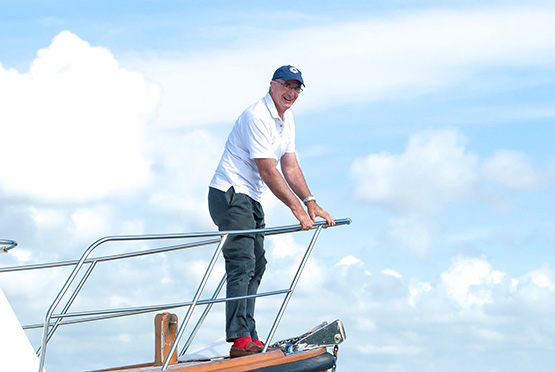 The Stag at Bay? Anthony O’leary sniffs the breeze last weekend, in charge of racing in the CH Marine Autumn league. This weekend he defends his All-Ireland title in Dun Laoghaire. Photo: Robert Bateman
The Stag at Bay? Anthony O’leary sniffs the breeze last weekend, in charge of racing in the CH Marine Autumn league. This weekend he defends his All-Ireland title in Dun Laoghaire. Photo: Robert Bateman
 Sailing should be fun, and run with courtesy – invitation to enjoyable racing, as displayed last weekend in Cork on Anthony O’Leary’s Committee Boat. Photo: Robert Bateman
Sailing should be fun, and run with courtesy – invitation to enjoyable racing, as displayed last weekend in Cork on Anthony O’Leary’s Committee Boat. Photo: Robert Bateman
But what those pioneering performance dinghy racers in 1946 can scarcely have imagined was that, 69 years later, no less than a quarter of the coveted places in the All-Ireland Championship lineup of 16 sailing stars would be going to helms who have qualified through winning their classes within the Annual National Championship of a thirteen-year-old all-Ireland body known as the Irish Cruiser-Racing Association.
And if you then further informed those great men and women of 1946 that those titles were all won in an absolute humdinger of a four-day big-fleet national championship staged in the thriving sailing centre and Irish gourmet capital of Kinsale, they’d have doubted your sanity. For in the late 1940s, Kinsale had slipped almost totally under the national sailing radar, while the town generally was showing such signs of terminal decline that there was little enough in the way of resources to put any food on any table, let alone think in terms of destination restaurants.
So in tracing the history of this uniquely Irish championship (for it long pre-dates the Endeavour Trophy in England), we have a convenient structure to hold together a manageable narrative of the story of Irish sailboat racing since the end of World War II. Add in the listings of the Irish Cruising Club trophies since the first one was instituted in 1931, then cross-reference this info with such records as the winners of the Round Ireland race and the Dun Laoghaire to Dingle Race, beef it all up with the winners of the national championship of the largest dinghy and inshore keelboat classes, and a comprehensible narrative of our national sailing history emerges.
 The veteran X332 Equinox (Ross McDonald) continues to be a force in Irish cruiser-racing, and by winning her class in the ICRA Nationals in Kinsale at the end of June, Equinox is represented in the All Irelands this weekend by helmsman Simon Rattigan. Photo: W M Nixon
The veteran X332 Equinox (Ross McDonald) continues to be a force in Irish cruiser-racing, and by winning her class in the ICRA Nationals in Kinsale at the end of June, Equinox is represented in the All Irelands this weekend by helmsman Simon Rattigan. Photo: W M Nixon
It’s far from perfect, but it’s a defining picture nevertheless, even if it lacks the inside story of the clubs. Be that as it may, in looking at it properly, we get a greater realization that the All-Ireland Helmsman’s Championship (or whatever you’re having yourself) is something very important, something to be cherished and nurtured from year to year.
Of course I’m not suggesting that we should all be out in Dublin Bay today and tomorrow on spectator boats, avidly watching every twist and turn as eight identical boats race their hearts out with a variety of helms calling the shots. Unless you’re in a particular helmsperson’s fan club, it’s really rather boring to watch from end to end, or at least until the conclusion of each stage and then the final races.
This is very much a sport for the “edited highlights”. The reality is that no matter how they try to jazz it up, sailing is primarily of interest only to those actively taking part, or directly engaged in staging each event. When great efforts are made to make it exciting for casual spectators, it costs several mints and results in rich people and highly-resourced teams engaged in costly and often unseemly battles to which genuine sporting sailors cannot really relate at all.
But with its exclusion of Olympic and some High Performance squad members, the All-Ireland in its current form is the quintessence of Irish local and national sailing. It’s almost compulsive for its participants, it provides an extra interest for their supportive clubmates, and in its pleasantly low key way it’s a genuine expression of real Irish sailing, the sailing of L’Irlande profonde.
So of course we agree that it might be more interesting for the bright young people if it was raced in something more trendy like the RS400s if they could find sufficient owners to risk their boats in this particular bear pit. And yes indeed, the ISA Discussion Paper and Helmsmans Guidelines of 2012 did indeed hope that within three years, the All Ireland would be staged in dinghies.
But we have to live in the real world. Sailing really is a sport for life, and some of our best sailors are truly seniors who would be disadvantaged if it was raced in a boat making too many demands on sheer athleticism, for which the unattainable Olympic Finn would be the only true answer.
But in any case, if you watch J/80s racing in a breeze, there’s no doubting the advantage a bit of athletic ability confers, yet the cunning seniors can overcome their lack of suppleness and agility with sheer sailing genius.
 While they may be keelboats, in a breeze the J/80s will sail better with some athleticism, as displayed here by Ben Duncan (second left) as he sweeps toward the finish and victory in the 2013 All Irelands at Howth. Photo: Aidan Tarbett
While they may be keelboats, in a breeze the J/80s will sail better with some athleticism, as displayed here by Ben Duncan (second left) as he sweeps toward the finish and victory in the 2013 All Irelands at Howth. Photo: Aidan Tarbett
 Yet a spot of sailing genius can offset the adverse effects of advancing years – Anthony O’Leary (right) with Dylan Gannon (left) and Dan O’Grady after snatching victory at the last minute in 2014. Photo: Jonathan Wormald.
Yet a spot of sailing genius can offset the adverse effects of advancing years – Anthony O’Leary (right) with Dylan Gannon (left) and Dan O’Grady after snatching victory at the last minute in 2014. Photo: Jonathan Wormald.
But another reality we have to accept is that Ireland is only just crawling out of the Great Recession. And in that recession, it was the enduring competitiveness of ageing cruiser-racers and the sporting attitude of their owners which kept the national sailing show on the road. Your dyed-in-the-wool dinghy sailor may sneer at the constrictions of seaborn truck-racing. But young sailors who were realists very quickly grasped that if they wanted to get regular sailing with good competition as the Irish economy went into free fall, then they had to hone their skills in making boats with lids, crewed by tough old birds most emphatically not in the first flush of youth, sail very well indeed.
Thus in providing a way for impecunious young people to keep sailing through the recession, ICRA performs a great service for Irish sailing. And the productive interaction between young and old in the ICRA fleets, further enlivened by their different sailing backgrounds, has resulted in a vibrant new type of sailing community where it is regarded as healthily normal to be able to move between dinghies and keelboats and back again.
The final lineup of entries is a remarkable overview of the current Irish racing scene, and if you wonder why the winner of the GP14 British Opens 2015, Shane McCarthy of Greystones, is not representing the GP 14s, the word is he’s unavailable, so his place is taken by Niall Henry of Sligo.
2014 Champion Anthony O'Leary, RCYC
RS400 Alex Barry, Monkstown Bay SC
GP14 Niall Henry ,Sligo Yacht Club
Shannon OD Frank Browne, Lough Ree YC
Flying Fifteen David Gorman, National YC
Squib Fergus O'Kelly, Howth YC
ICRA 1 Roy Darrer, Waterford Sailing Club
Mermaid Patrick, Dillon Rush SC
Laser Std Ronan Cull, Howth YC
SB20 Michael O'Connor, Royal St.George YC
IDRA14 Alan Henry, Sutton DC
RS200 Frank O'Rourke, Greystones SC
ICRA 2 Simon Rattigan, Howth YC
ICRA 4 Cillian Dickson, Howth YC
Ruffian Chris Helme, Royal St.George YC
As a three-person boat with a semi-sportsboat performance, the J/80 is a reasonable compromise between dinghies and keelboats, and the class has the reputation of being fun to sail, which is exactly what’s needed here.
The Sailing Olympics and the ISAF Worlds may be terribly important events for sailing in the international context, but nobody would claim they’re fun events. Equally, though, you wouldn’t dream of suggesting the All-Ireland is no more than a fun event. But it strikes that neat balance between tough sport and sailing enjoyment to make it quite a good expression of the true Irish amateur sailing scene.
Inevitably from time to time it produces a champion whose sailing abilities are so exceptional that it would amount to a betrayal of their personal potential for them not to go professional in some way or other. But fortunately sailing is such a diverse world that two of the outstanding winners of the Helmsman’s Championships of Ireland have managed to make their fulfilled careers as top level professional sailors without losing that magic sense of fun and enjoyment, even though in both cases it has involved leaving Ireland.
Their wins were gained in the classic early Irish Yachting Association scenario of a one design class which functioned on a local basis being able to provide enough reasonably-matched boats to be used for the Helmsman’s, and the three I best remember were when Gordon Maguire won in 1982 on Lough Derg racing Shannon One Designs, then in the 1970s Harold Cudmore won on Lough Neagh racing Flying Fifteens, and in 1970 itself, a very young Robert Dix was winner racing National 18s at Crosshaven.
Gordon Maguire was the classic case of a talented sailor having to get out of Ireland to fulfill himself. His win in 1982 in breezy conditions at Dromineer in Shannon One Designs, with Dave Cummins of Sutton on the mainsheet, was sport at its best, though I doubt that some of the old SODs were ever the better again after the hard driving they received.
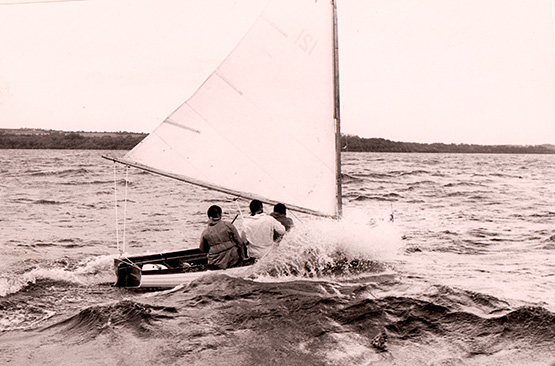 Driving force. Gordon Maguire going indecently fast for a Shannon One Design, on his way to winning the Helmsmans Championship of Ireland at Dromineer in 1982. Photo: W M Nixon
Driving force. Gordon Maguire going indecently fast for a Shannon One Design, on his way to winning the Helmsmans Championship of Ireland at Dromineer in 1982. Photo: W M Nixon
Then Gordon spread his wings, and won the Irish Windsurfer Nationals in 1984 - a great year for the Maguires, as his father Neville (himself a winner of the Helmsmans Championship five times) won the ISORA Championship with his Club Shamrock Demelza the same weekend.
But Gordon needed a larger canvas to demonstrate his talents, and in 1991 he was a member of the Irish Southern Cross team in Australia, a series which culminated in the Sydney-Hobart Race. The boat which Maguire was sailing was knocked out in a collision with another boat (it was the other boat’s fault), but Maguire found a new berth as lead helm on the boat Harold Cudmore was skippering for the Hobart Race, and they won that overall.
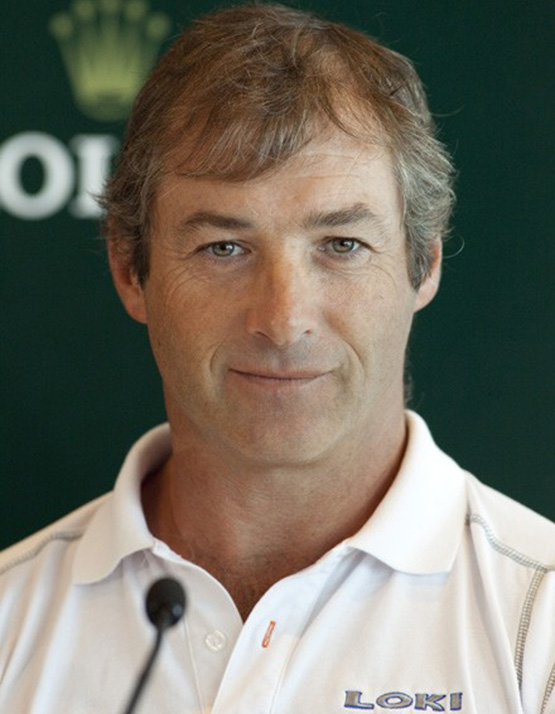 A man fulfilled, Gordon Maguire at the beginning of his hugely successful linkup with Stephen Ainsworth’s RP 63 Loki
A man fulfilled, Gordon Maguire at the beginning of his hugely successful linkup with Stephen Ainsworth’s RP 63 Loki
And Gordon Magure realized that for his talents, Australia was the place to be. More than twenty years later, he was to get his second Hobart Race overall win in command of Stephen Ainsworth’s RP 63 Loki, and here indeed was a man fulfilled, revelling in a chosen career which would have been unimaginable in Ireland.
Harold Cudmore had gone professional as best he could in 1974, but it was often a lonely and frustrating road in Europe. However, his win of the Half Ton Worlds in Trieste in the Ron Holland-designed, Killian Bushe-built Silver Shamrock in 1976 put his name up in lights, and he has been there ever since, renowned for his ability to make any boat perform to her best. It has been said of him when racing the 19 Metre Mariquita in the lightest conditions, that you could feel him getting an extra ounce of speed out of this big and demanding gaff-rigged classic seemingly by sheer silent will power.
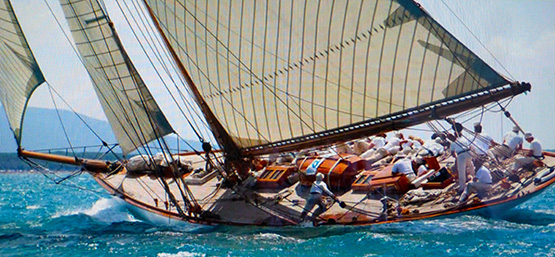
The restored 19 Metre Mariquita is a demanding beast to sail in any conditions…

...but in light airs, Harold Cudmore (standing centre) seems to be able to get her to outsail larger craft by sheer will-power.
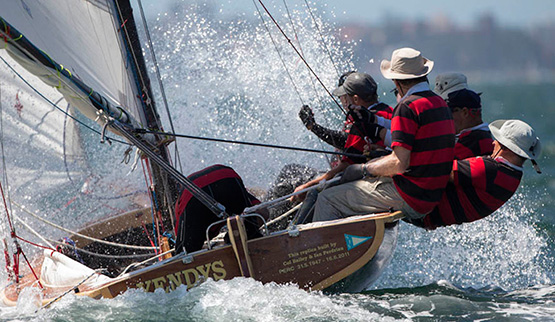 A different scene altogether, but still great sport – Harold Cudmore racing the classic Sydney Harbour 18-footer Yendys
A different scene altogether, but still great sport – Harold Cudmore racing the classic Sydney Harbour 18-footer Yendys
But as for Robert Dix’s fabulous win in 1970, while he went on to represent Ireland in the 1976 Olympics in Canada, he has remained a top amateur sailor who is also resolutely grounded in Irish business life (albeit at a rather stratospheric level). But then it could be argued that nothing could ever be better than winning the Helmsmans Championship of Ireland against the cream of Irish sailng when you’re just 17 years old, and doing it all at the mother club, the Royal Cork, as it celebrated its Quarter Millenium.
It was exactly 44 years ago, the weekend of October 3rd-4th 1970, and for Robert Dix it was a family thing, as his brother-in-law Richard Burrows was Number 2 in the three-man setup. They were on a roll, and how. The manner in which things were going their way was shown in an early race when they were in a tacking duel with Harold Cudmore. Coming to the weather mark, Cudmore crossed them on port, but the Dix team had read it to such perfection that by the time he had tacked, they’d shot through the gap with inches to spare and Cudmore couldn’t catch them thereafter.

Decisive moment in the 1970 Helmsman’s Championship. At the weather mark, Harold Cudmore on port is just able to cross Robert Dix on starboard………Photo W M Nixon
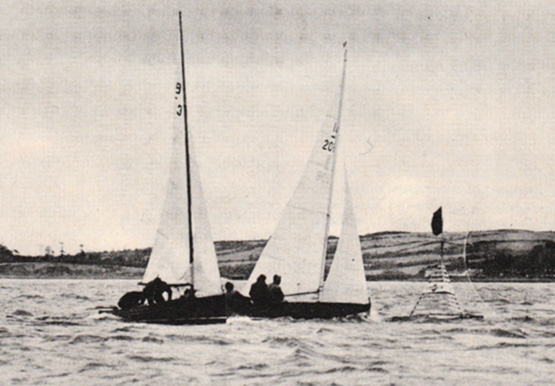 ……but Dix is able to shoot through the gap as Cudmore tacks…..Photo: W M Nixon
……but Dix is able to shoot through the gap as Cudmore tacks…..Photo: W M Nixon
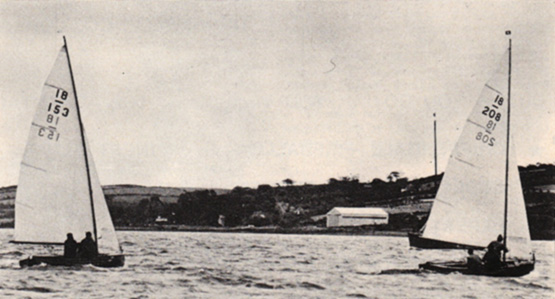 …..and is on his way to a win which will count well towards his overall victory over Cudmore by 0.4 points. Photo: W M Nixon
…..and is on his way to a win which will count well towards his overall victory over Cudmore by 0.4 points. Photo: W M Nixon
Admittedly both Harold Cudmore and the equally-renowned Somers Payne had gear problems, but even allowing for that, the 17-year-old Robert Dix from Malahide was the star of the show, and the final points of Robert Dix 9.5 and Harold Cudmore 9.9 for the 1970 Helmsman’s Championship of Ireland says it all, and it says it as clearly now as it did then.
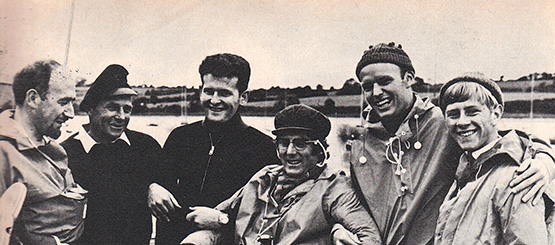
The six finalists in the 1970 Helmsman’s Championship were (left to right) Michael O’Rahilly Dun Laoghaire), Somers Payne (Cork), Harold Cudmore (Cork), Owen Delany (Dun Laoghaire), Maurice Butler (Ballyholme, champion 1969) and Robert Dix (Malahide), at 17 the youngest title holder ever. Photo: W M Nixon
#sailing – Irish Sailing Association (ISA) President David Lovegrove on the summer ahead
The sun is finally showing its face on Irish waters, and just in time as the summer sailing season is now in full swing, with boats taking to the water in higher numbers than previous years. I am in regular contact with Clubs across the country and they speak of the positive mood coursing its way through their sailing communities.
Much of this of course has to do with the resurgence of the Irish economy following years of austerity, cutbacks, and a drop in sailing participation. The marine industry now reports that sales of boats coming into the country are on the up; handicap applications are increasing following a lull in requests, and this can only mean one thing – more boats on the water. The Irish Cruiser Racing Association (ICRA) Nationals, Sovereigns Week and Dun Laoghaire Week are all benefitting, with buoyant numbers reported as boats come out to compete in what should be a bumper summer season.
This summer will also see DinghyFest hit the shores of Crosshaven, Royal Cork Yacht Club (RCYC) creating a new event - could this herald the resurgence of Dinghy Week? I note the cooperation between the ISA and the dinghy classes, which I hope will lead to an upsurge in the numbers of dinghy sailors, which fits with our policy of growing this area within Irish sailing.
In other positive news, it was great to hear that the ISA has won the National Inclusion Award under the category of National Governing Body of Sport for the commitment and focus displayed in respect to providing sport and physical activity opportunities for people with disabilities.
I am also pleased to announce that SafeTrx, the ISA app that monitors your boat journeys and alerts Emergency Contacts should you fail to return on time, has been shortlisted for the Maritime Industry Awards in the categories of Innovation in Maritime Safety and Innovation in Marine Technology.
On 18 June, the Minister for Agriculture, Food and the Marine, Simon Coveney launched Try Sailing on board the Jeanie Johnston in Dublin. Try Sailing is a national initiative, designed to drive participation in sailing locally through open days and events at centres and clubs across the country. For more information, visit www.trysailing.ie
Spring saw the ISA AGM adopt the Strategic Plan 2015-2020 – the blueprint for the future of sailing in Ireland. This plan is now being implemented across the key areas within sailing. The AGM elected two new officers to the Board, and said goodbye to Mike O'Connor and Phillip Cowman, who both retired after seven years on the ISA Board. I would like to thank them for their service and welcome to the Board Robert Dix, former ISA President and Chairman of the Government Taskforce on Harnessing our Ocean Wealth; and Paddy McGlade, ex-RCYC Admiral and member of the Irish Cruising Club and Cruising Association of Ireland.
On the Performance side of the house, Providence Team IRL has been competing on a number of fronts, notably at the World Cup series and significant international-class regattas, such as the Delta Lloyd, where Annalise Murphy in the Laser Radial claimed a Silver medal in trying conditions amidst a fleet of top sailors, including Olympic Silver and Bronze medallists. I was also delighted to see 16–year–old Aoife Hopkins from my own Howth Yacht Club secure an invite to the World Cup Series event at Weymouth in the Laser Radial class. Aoife has put in a series of impressive performances this year, including a big week at the Delta Lloyd Regatta in late May.
On the Paralympics front, the ISA is working with the International Sailing Federation (ISAF) to lobby the International Olympic Committee to reinstate Paralympic sailing at the Tokyo 2020 Paralympics.
Enjoy your summer sailing.
David Lovegrove
President, Irish Sailing Association.



























